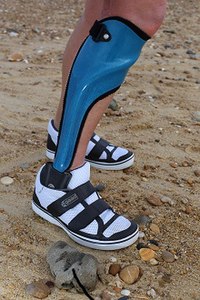
Photo from wikipedia
OBJECTIVE To compare the metabolic demands of walking in individuals with lower limb injury with and without ankle-foot orthosis (AFO) use. A secondary aim was to compare these results to… Click to show full abstract
OBJECTIVE To compare the metabolic demands of walking in individuals with lower limb injury with and without ankle-foot orthosis (AFO) use. A secondary aim was to compare these results to individuals to those from individuals with unilateral transtibial amputation and able-bodied controls. DESIGN Cross Sectional Study. SETTING Two clinical research centers PARTICIPANTS: Thirteen individuals with lower limb injury who used a passive-dynamic AFO underwent metabolic analysis at three standardized speeds with and without their AFO. Results were compared to individuals with unilateral transtibial amputation (TTA) who used a passive prosthetic foot and able-bodied controls with no musculoskeletal, neurological, or cardiovascular deficits. MAIN OUTCOME MEASURES Oxygen consumption, heart rate, and rating of perceived exertion. RESULTS The use of the passive-dynamic AFO did not significantly change energetic demand (oxygen consumption, heart rate, perceived exertion) in participants with a LL injury. Heart rate (p<0.037) was significantly greater than able-bodied controls but perceived exertion was significantly lower (p≤0.031). There were no significant differences between participants with a LL injury (with or without the AFO) and individuals with TTA. CONCLUSION Many individuals with LL injuries may expect to use passive-dynamic AFOs at little-to-no metabolic consequence. The stabilizing and assistive benefits of the AFO likely balance with its well-known range of motion limitations and power reductions. Passive-dynamic AFO use can sometimes be an alternative for individuals considering TTA. These results support that AFO users may be able to achieve similar energetic demands as those with amputation.
Journal Title: Archives of physical medicine and rehabilitation
Year Published: 2022
Link to full text (if available)
Share on Social Media: Sign Up to like & get
recommendations!